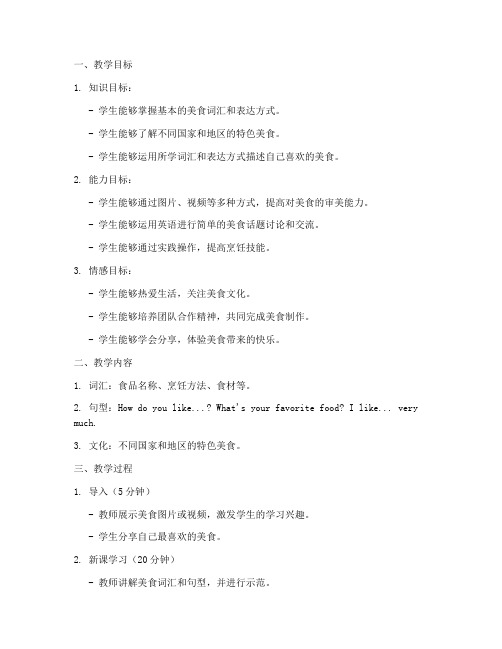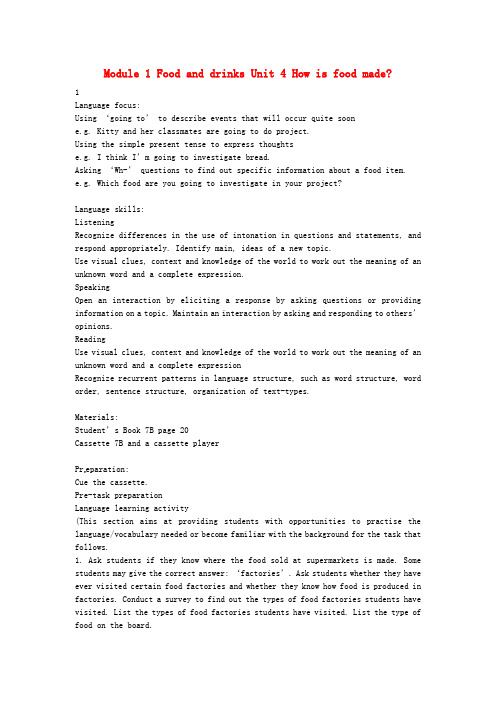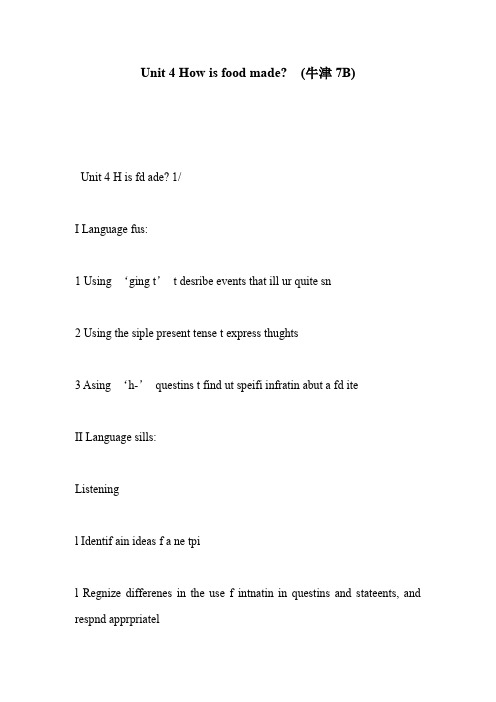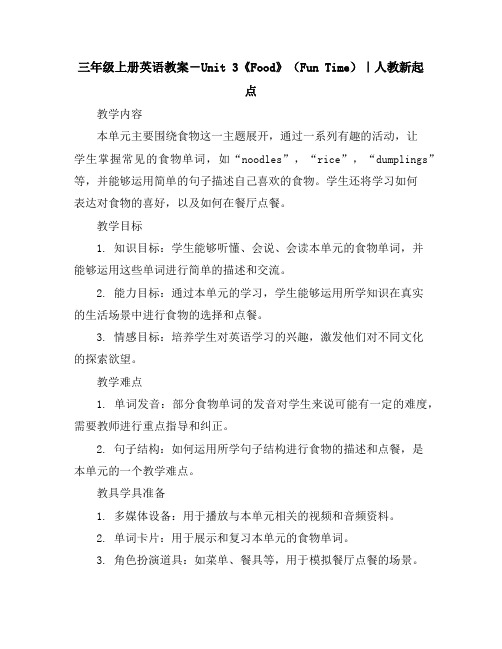How is food made教案
Unit3Food(教学设计)2024-2025学年人教新起点版英语三年级上册

Unit3 Food(教学设计)2024-2025学年人教新起点版英语三年级上册一、教学目标知识与技能目标:学生能够掌握与食物相关的基本词汇,如:hamburger, sandwich, egg, hot dog, cake, bread等。
学生能够运用所学词汇进行简单的英语交流,如:I like hamburgers. Do you like cake? 等。
学生能够听懂并指认教师描述的食物。
过程与方法目标:通过观察和模仿,培养学生识别食物图片和实物的能力。
通过角色扮演和小组活动,提高学生的口语表达能力和合作能力。
情感、态度与价值观目标:激发学生对食物的兴趣,了解不同食物的营养价值。
培养学生健康饮食的习惯和分享食物的乐趣。
二、教学内容分析本单元主要围绕“食物”这一主题展开,介绍了与食物相关的基本词汇和句型。
通过学习,学生能够掌握这些词汇,并在实际情境中运用所学知识进行简单的英语交流。
本单元的重点是食物词汇的发音和拼写,以及简单句型的运用。
三、学情分析三年级的学生已经具备了一定的英语基础,对于简单的英语词汇和句型有了一定的了解。
但是,他们可能对于如何用英语准确描述和讨论食物还不够熟悉。
因此,在教学中,教师应注重从学生的实际生活出发,通过直观、生动的教学方法帮助学生理解和掌握所学内容。
四、教学方法与手段直观教学法:利用食物图片、实物等直观材料展示食物,帮助学生理解词义。
情境教学法:创设与学生生活密切相关的情境,让学生在情境中学习和运用英语。
角色扮演法:让学生扮演不同的角色,如服务员、顾客等,在模拟的情境中练习对话。
多媒体辅助教学:利用多媒体课件展示教学内容,丰富教学手段。
五、教学重难点教学重点:食物词汇的发音和拼写。
简单句型的运用和表达。
教学难点:学生在实际情境中灵活运用所学英语描述和讨论食物。
六、教学过程Step 1: 导入(Lead-in)教师与学生进行简单的问候,并询问学生今天早餐/午餐吃了什么,引出食物的话题。
美食双语教案设计方案模板

一、教学目标1. 知识目标:- 学生能够掌握基本的美食词汇和表达方式。
- 学生能够了解不同国家和地区的特色美食。
- 学生能够运用所学词汇和表达方式描述自己喜欢的美食。
2. 能力目标:- 学生能够通过图片、视频等多种方式,提高对美食的审美能力。
- 学生能够运用英语进行简单的美食话题讨论和交流。
- 学生能够通过实践操作,提高烹饪技能。
3. 情感目标:- 学生能够热爱生活,关注美食文化。
- 学生能够培养团队合作精神,共同完成美食制作。
- 学生能够学会分享,体验美食带来的快乐。
二、教学内容1. 词汇:食品名称、烹饪方法、食材等。
2. 句型:How do you like...? What's your favorite food? I like... very much.3. 文化:不同国家和地区的特色美食。
三、教学过程1. 导入(5分钟)- 教师展示美食图片或视频,激发学生的学习兴趣。
- 学生分享自己最喜欢的美食。
2. 新课学习(20分钟)- 教师讲解美食词汇和句型,并进行示范。
- 学生跟读,练习发音和语调。
- 教师带领学生进行小组讨论,运用所学词汇和句型描述自己喜欢的美食。
3. 实践操作(20分钟)- 教师讲解简单的烹饪方法,如炒、煮、烤等。
- 学生分组,共同完成一道美食的制作。
- 教师巡视指导,确保学生掌握正确的烹饪技巧。
4. 交流展示(10分钟)- 学生展示自己制作的美食,并用英语介绍。
- 教师和学生共同评价,分享美食制作的乐趣。
5. 总结(5分钟)- 教师总结本节课所学内容,强调美食词汇和句型的运用。
- 学生分享学习心得,表达对美食文化的热爱。
四、教学评价1. 课堂表现:学生参与度、合作精神、语言表达能力。
2. 实践操作:学生掌握烹饪技巧、完成美食制作的情况。
3. 课后作业:学生运用所学知识,完成一篇关于自己家乡美食的英语短文。
五、教学资源1. 美食图片、视频、教材。
2. 烹饪工具、食材。
初中英语食物课程教案模板

课时安排:2课时教学目标:1. 知识目标:掌握基本的英语食物词汇,了解食物的英语表达方式。
2. 能力目标:能够运用所学词汇进行简单的食物描述和交流。
3. 情感目标:激发学生对英语学习的兴趣,培养跨文化交流的能力。
教学重点:1. 食物类词汇的拼写和发音。
2. 食物描述的基本句型。
教学难点:1. 食物词汇的拼写和记忆。
2. 在实际交流中灵活运用食物描述句型。
教学准备:1. 教学课件:包含食物图片、单词卡片、例句等。
2. 教学视频:有关食物的英语介绍视频。
3. 实物教具:各种食物模型或图片。
教学过程:第一课时一、导入1. 用简单的英语问好,引入话题:“Good morning, class. Do you like food? What kind of food do you like?”2. 展示一些食物图片,让学生用英语描述。
二、新课教授1. 词汇教学:- 展示食物图片,引导学生说出相应的英语单词。
- 将单词卡片分发给学生,让学生通过卡片记忆单词。
- 通过游戏或小组活动,让学生在语境中运用单词。
2. 句型教学:- 引导学生用“I like...”句型表达自己喜欢的食物。
- 通过示例句,让学生学习如何描述食物的特点,如“ 这个苹果很甜。
”三、巩固练习1. 小组活动:让学生分组,用所学词汇和句型描述食物。
2. 游戏环节:进行“Food Charades”(食物猜谜)游戏,提高学生的参与度和兴趣。
四、总结1. 回顾本节课所学食物词汇和句型。
2. 强调食物词汇在日常生活交流中的重要性。
第二课时一、复习1. 复习上一节课所学的食物词汇和句型。
2. 让学生用所学知识进行简单的食物描述。
二、拓展1. 引导学生了解不同国家的食物文化。
2. 展示各国特色食物图片,让学生用英语介绍。
三、实践活动1. 让学生分组,每组选择一种食物,用英语制作食物介绍海报。
2. 每组派代表进行海报展示,其他组学生进行提问和回答。
四、总结1. 回顾本节课所学内容。
七年级英语下册 Module1 Unit4 How is food made教案 上海牛津版

Module 1 Food and drinks Unit 4 How is food made?1Language focus:Using ‘going to’ to describe events that will occur quite soone.g. Kitty and her classmates are going to do project.Using the simple present tense to express thoughtse.g. I think I’m go ing to investigate bread.Asking ‘Wh-’ questions to find out specific information about a food item.e.g. Which food are you going to investigate in your project?Language skills:ListeningRecognize differences in the use of intonation in questions and statements, and respond appropriately. Identify main, ideas of a new topic.Use visual clues, context and knowledge of the world to work out the meaning of an unknown word and a complete expression.SpeakingOpen an interaction by eliciting a response by asking questions or providing information on a topic. Maintain an interaction by asking and responding to others’ opinions.ReadingUse visual clues, context and knowledge of the world to work out the meaning of an unknown word and a complete expressionRecognize recurrent patterns in language structure, such as word structure, word order, sentence structure, organization of text-types.Materials:Student’s Book 7B page 20Cassette 7B and a cassette playerPr eparation:Cue the cassette.Pre-task preparationLanguage learning activity(This section aims at providing students with opportunities to practise the language/vocabulary needed or become familiar with the background for the task that follows.1. Ask students if they know where the food sold at supermarkets is made. Some students may give the correct answer: ‘factories’. Ask students whether they have ever visited certain food factories and whether they know how food is produced in factories. Conduct a survey to find out the types of food factories students have visited. List the types of food factories students have visited. List the type of food on the board.2. Ask any students who have visited food factories to talk about their visited. If most of the students have never visited a food factory, a class trip to a factory could be arranged to give them background knowledge in food production. Encourage students to talk about what food production they would like to know more about3. Tell student they are going to do a project on investigating how a certain kind of food is made. Explain to students the meaning of the world ‘investigate’. Ask individuals the subject of their investigation, like this: Which food are you going to investigate in your project? to elicit: I am going to investigate (name of food). /My project is going to be about (name of food).4. Play the recording: Read. Students listen and follow in their books.5. Ask students to say what food the children in Read have chosen to study.6. Review the food vocabulary in Look, ask and answer. Ask students to suggest some more food items they would like to investigate.7. Students work in pairs to ask and answer questions about a food project in Look, ask and answer using the target language.2Language focus:Using connectives to show a resulte.g. I’m investigating how food is put cans, so I need to talk to someone at a canning factory.Using ‘going to’ to describe events that will occur quite soon.e.g. My project’s going to be about orange juice.Asking ‘Wh-’ questions to find out specifi c information about a thing and a person.e.g. What’s your project going to be about?/ Who do you need to interview for your project?Language skills:ListeningRecognize differences in the use of intonation in questions and statements, and respond appropriately. Unde rstand the connection between ideas by recognizing linking words and phrases.SpeakingOpen an interaction by eliciting a response by asking questions or providing information on a topic. Maintain an interaction by asking and responding to others’ opinions.ReadingRecognize recurrent patterns in language structure, such as word structure, word order, sentence structure, organization of text-types.Understand the connection between ideas by identifying linking words or phrases. Scan a text to locate specific informationMaterials:Stu dent’s Book 7B page 21Cassette 7B and a cassette playerWorkbook 7B page 13Photocopiable page 15Preparation:Cue the cassette. Make a copy of Photocopiable page 15 for each group.Pre-task preparationLanguage learning activity(This section aims at providing students with opportunities to practise the language/vocabulary needed or become familiar with the background for the task that follows.1. Write on the board a list of food items and a list of food factories in two separate columns. Tell students to match the food items to the factories, e.g. yoghurt to dairy; frozen fish to frozen fish factory; noodles to noodle factory, etc. Ask individuals to suggest some more food items they want to investigate and the kind of factory they will visit. Add their suggestion to the columns.2. Ask individuals questions, like this: What is your project going to be about? To elicit: My project’s going to be about (name of food). Then ask: Who do you need to interview for your project? To elicit: I need to interview someone at a (place).3. Invite students to come forward and talk about the food item they are going to investigate, like this: I’m investigating how yoghurt is made, so I need to interview someone at a dairy. Explain to students that they should use the connective ‘so’ to explain what action they are going to take to do the investigation. Remember there is no need for students to learn the passive voice at this stage.4. Have students read Look and read for some time. Then play the recording. Students listen and follow in their books.5. Invite several students to role-play Miss Guo, Kitty and her classmates to ask and answer questions using the target language in Ask and answer, based on the contents of Look and read.6. Invite a student to come forward and ask his/her classmates questions about the projects they have chosen to investigate.7. Students work in groups. Distribute a copy of Photocopiable page 15 to each group. Student tell one another what food they are going to investigate and who they intend to interview. Students fill in the table and organize the information into a short report.ConsolidationGrammar Practice Book 7B page 15Workbook page 133Language focus:Asking ‘Wh-’ questions to find out specific information about a place.e.g. Where do you get the fish from?Asking ‘Wh-’ questions to find out specific information about something.e.g. What do you do to the fish before you freeze it?Asking ‘Wh-’ questions to find out specific informa tion about a reason.e.g. Why do you freeze the fish?Asking ‘How’ questions to find out specific information about a method.e.g. How do you get the frozen fish to the shops?Language skills:ListeningRecognize differences in the use of intonation in questions and statements, and respond appropriately. Listen for specific informationSpeakingOpen an interaction by eliciting a response by asking questions or providing information on a topicReadingRecognize format and language features in non-narrative texts.WritingDevelop written texts by using appropriate format, conventions and language feature features when writing non-narrative texts.Materials:Student’s Book 7B page 22Cassette 7B and a cassette playerWorkbook 7B page 15Photocopiable pages 16 and 17Preparation:Cue the cassette. Make a copy of Photocopiable page 16 and 17 for each student.Pre-task preparation1. Review with students the use of interrogatives by asking students questions about their food projects, like this: What is your project about? Why did you choose to investigate (name of food/drink)? Where are you going to visit? Who do you need to interview? How are you going to visit the person? Write students’ answers to the questions on the board.2. Tell students to read E ddie’s questions for the frozen fish factory. Play the recording: Look and read. Students listen and follow in their books.3. Students pair up to practise the dialogue between Danny and the man at the frozen fish factory. Invite some pairs to come forward to act out the interview and read the dialogue.4. Ask questions: Where do the people at the frozen fish factory get the fish from? What do they do to the fish before they frozen it? Why do they freeze the fish? Howdo they get the frozen fish to the shops? Students are required to give short answers to show their understanding of the key points.5. Distribute a copy of Photocopiable page 16 each student. Tell students to complete Eddie’s notes about his visit to the frozen fish factory. Students in pairs read each other’s notes and make corrections if necessary.ConsolidationWorkbook page 15Grammar Practice Book 7B page 164Language focus:Using formulaic expressions to begin a formal letter.e.g. Dear Sir/Madam.Using formulaic expressions to end a formal lettere.g. I look forward to hearing from you./ Yours sincerely.Using modals to indicate preferencese.g. I would like to visit your dairy.Asking ‘Wh-’ questions to find out specific information about a day.e.g. Which day will be convenient for me to visit the dairy?Language skills:ReadingScan a text a locate specific informationRecognize the presentation of ideas through heading, Paragraphing, spacing, italic, bold print and punctuationUnderstand intention, attitude and feeling stated in a text by recognizing features such as the choice and use of language.Materials:Student’s Book 7B page 23Cassette 7B and a cassette playerPreparation:Cue the cassette.Pre-task preparationLanguage learning activity(This section aims at providing students with opportunities to practise the language/vocabulary needed or become familiar with the background for the task that follows.1. Review the format of a letter with students, telling them that there are formal and informal letters. Draw students’ attention to the salutation and the complimentary closing which usually indicate whether a letter is in a formal orinformal style, as in Dear Sir/Madam and Dear Danny: Yours sincerely and Love. Bring in the two types of letters and show them to students.2. Have students read Danny’s letter to the dairy. Ask students whether it is a formal or informal letter and the reason for Danny to have written a formal letter. Explain to students under what circumstances and conditions a formal letter is more appropriate. Play the recording: Read. Students listen and follow in their books.ConsolidationGrammar Practice Book 7B page 175Language focus:Using formulaic expression to begin a formal lettere.g. Dear Sir/MadamUsing formulaic expressions to end a formal letter.e.g I look forward to heading from you,/Yours sincerely.Using modals to indicate preferencese.g. I would like to visit your _________.Asking ‘Wh-’ questions to find out specific information about a day.e.g. Which day will be convenient for me to visit ______ ?Language skills:WritingGather and share information, ideas and language by brainstorming, listing and observing.Plan and organize information and ideas by indentifying purpose and audience for a writing task.Develop written texts by expressing ideas and feelings and by writing paragraphs which present ideas logically. Revise and edit short texts by making changes to incorrect spelling, punctuation and grammar, and adding details if necessary in resp onse to suggestions from the teacher.Materials:Student’s Book 7B page 24Cassette 7B and a cassette playerWorkbook 7B page 14ConsolidationGrammar Practice Book 7B page 146Language focus:Using the simple present tense to express needse.g. You also need a saucepan and a flask.Using imperatives to give instructionse.g. Mix, Take, Add, Pour, OpenAsking ‘WH-’ question to find out specific information about somethinge.g. What do you need to make you yoghurt?Using adverbs to express time sequencee.g. First, …/ Secondly, …/ Next, …/ Then /After that, … / Finally, …Language skills:ListeningRecognize differences in the use of intonation in questions and statements, and respond appropriately.Identify main ideas of a new topicListen for specific informationReadingUse visual clues, context and knowledge of the world to work out the meaning of an unknown word and a complete expressionRecognize format and language features in narrative and non-narrative texts. Predict the likely development of a topic by recognizing key words and making use of contexts and knowledge of the world.Scan a text to locate specific inform ationMaterials:Student’s Book 7B page 25Cassette 7B and a cassette playerWorkbook 7B page 16Photocopiable page 18 and 82Preparation:Cue the cassette. Make a copy of Photocopiable page 18 and 82 for each student.Pre-task preparation1. Introduce to students the ingredients and cooking utensils needed to make yoghurt in Look and read. Ask students: What do you need to make yoghurt? To elicit: You need …2. Give students some time to look at the photos and read the captions to understand the procedures for making yoghurt. Ask individual students: What do you do first? To elicit: First, you mix the milk and the powdered milk in the saucepan. Heat …, What do you do secondly/next/then/after that/ finally? To elicit corresponding answers to the questions3. Play the recording: Look and re ad. Students listen and follow in their books. Pause the tape at the beginning of each procedure, ask students to read out an appropriate adverb of time, and continue playing the tape.ConsolidationGrammar Practice Book 7B page 18 and 21. Photocopiable page 19 and 24。
Unit 4 How is food made- (牛津7B)

Unit 4 How is food made? (牛津7B)Unit 4 H is fd ade? 1/I Language fus:1 Using ‘ging t’t desribe events that ill ur quite sn2 Using the siple present tense t express thughts3 Asing ‘h-’questins t find ut speifi infratin abut a fd iteII Language sills:Listeningl Identif ain ideas f a ne tpil Regnize differenes in the use f intnatin in questins and stateents, and respnd apprpriatell Use visual lues, ntext and nledge f the rld t r ut the eaning f an unnn rd and a plete expressinSpeaingl pen an interatin b eliiting a respnse b asing questins r prviding infratin n a tpil aintain an interatin b asing and respnding t ther’s pininsReadingl Use visual lues, ntext and nledge f the rld t r ut the eaning f an unnn rd and a plete expressinl Regnize reurrent patterns in language struturel Regnize frat and language features in narrative and nn-narrative textsIII aterials:l SB P20l assette 7BPredureI aring-up1 Free tal:l A hant: A perfet sreII Pre-tas preparatin:l here is fd ade? fatriesl Have u ever been t a fd fatr?l D a pret n h a ertain ind f fd is ade: hih fd are u ging t investigate in ur pret?I a ging t investigate breadpret is ging t be abut fd in ansl Read: 1) listen and flll L, as and anser: revie the fd vabulalr: frzen vegetables, range uie, heese, bisuits and rispsl Pair r: as and anser abut a fd pretIII nslidatin1 ral: 1) Listen and read ties2) Pair r: as and anser abut the pret2 ritten: 1) p r: ne rds and phrases2) Suppleentar exerisesIV NtesUnit 4 H is fd ade? 2/I Language fus:1 Using ‘ging t’t desribe events that ill ur quite sn2 Using nnetives t sh a result3 Asing ‘h-’questins t find ut speifi infratin abut a fd iteII Language sills:Listeningl Regnize differenes in the use f intnatin in questins and stateents, and respnd apprpriatell Understand the nnetin beteen ideas b regnizing lining rds and phrasesSpeaingl pen an interatin b eliiting a respnse b asing questins r prviding infratin n a tpil aintain an interatin b asing and respnding t ther’s pininsReadingl San a text t late speifi infratinl Regnize reurrent patterns in language struturel Understand the nnetin beteen ideas b identifing lining rds and phrases III aterials:l SB P21l assette 7Bl B P13l PP P1PredureI aring-up1 Free tal:l A hant: A perfet sreII Pre-tas preparatin:l Fd prdutin:fd fd fatrghurt dairfrzen fish frzen fish fatrndles ndles fatradd re t the lunsl Individual r:hat is ur pret ging t be abut?pret is ging t be abut anned fdh d u need t intervie fr ur pret?I need t intervie sene at a anning fatrl re ral pratie:I’investigating h fd is put int ans, s I need t tal t (intervie) sene at a anning fatrl L and read:1) read b urselves2)listen and fll3)rle-pla using the target languagel Grup r: PP P1: fill in the table and rganize the infratin int a shrt reprtIII nslidatin1 ral: 1) Listen and read ties2) Pair r: as and anser abut the pret2 ritten: 1) p r: ne rds and phrases2) B P133) GB P1IV NtesUnit 4 H is fd ade? 3/I Language fus:1 Asing ‘h-’questins t find ut speifi infratin abut a plae2 Asing ‘h-’questins t find ut speifi infratin abut sething3 Asing ‘h-’questins t find ut speifi infratin abut a reasn4 Asing ‘H’questins t find ut speifi infratin abut a ethd II Language sills:Listeningl Regnize differenes in the use f intnatin in questins and stateents, and respnd apprpriatell Listen fr speifi infratinSpeaingl pen an interatin b eliiting a respnse b asing questins r prviding infratin n a tpiReadingl Regnize frat and language features in narrative and nn-narrative textsIII aterials:l SB P22l assette 7Bl B P1l PP P16,17PredureI aring-up1 Free tal:l A hant: A perfet sreII Pre-tas preparatin:l Revie the use f interrgatives: hat is ur pret abut?h did u hse t investigate ghurt? here are u ging t visit?h d u need t intervie?H are u ging t visit the persn?l L and read:1) read b urselves2) listen and fll3) pair r: pratie the dialgue beteen Dann and the an at the frzen fatr4) at utl prehensin questins:here d the peple at the frzen fish fatr get the fish fr?hat d the d t the fish befre the freeze it?h d the freeze the fish?H d the get the frzen fish t the shps?l Individual r: PP P16: plete Eddie’s ntes abut his visit t the frzen fish fatr1) d it b urselves first2) read and rretIII hile-tas predure:l Pair r: PP P17: ae an intervieIII nslidatin1 ral: 1) Listen and read ties2) Pair r: as questins abut ur pret2 ritten: 1) p r: ne rds and phrases2) B P13) GB P16IV NtesUnit 4 H is fd ade? 4/I Language fus:1 Asing ‘h-’questins t find ut speifi infratin abut a da2 Using frulai expressins t begin a fral letter3 Using frulai expressins t end a fral letter4 Using dals t indiate preferenesII Language sills:Readingl San a text t late speifi infratinl Regnize the presentatin f ideas thrugh headings, paragraphing, spaing, italis, bld print and puntuatinl Understand intentin, attitude and feelings stated in a text b regnizing features suh as the hie and use f languageIII aterials:l SB P23, 24l assette 7BPredureI aring-up1 Free tal:l A hant: A perfet sreII Pre-tas preparatin:l Revie the frat the a letter:fral letters: Dear Sir/ada... urs sinerel infral letters: Dear Dann (v)l Read:1) Read Dann’s letter b urselves2) Is it a fral letter r an infral ne?3) hen is it apprpriate t use a fral letter?4) Listen and fllIII nslidatin1 ral: 1) Listen and read ties2) Pair r: as questins abut ur pret2 ritten: 1) p r: ne rds and phrases2) B P143) GB P174) plete the letter n P24 f ur SBIV NtesUnit 4 H is fd ade? /I Language fus:1 Using the siple present tense t express needs2 Asing ‘h-’questins t find ut speifi infratin abut sething3 Using adverbs t express tie sequene4 Using iperatives t give instrutinsII Language sills:Listeningl Regnize differenes in the use f intnatin in questins and stateents, and respnd apprpriatell Listen fr speifi infratinl Identif ain ideas f a ne tpiReadingl Regnize frat and language features in narrative and nn-narrative textsl San a text t late speifi infratinl Use visual lues, ntext and nledge f the rld t r ut the eaning f an unnn rd and a plete expressinl Predit the liel develpent f a tpi b regnizing e rds and aing use f ntext and nledge f the rldIII aterials:l SB P2l assette 7Bl B P16l PP P18,82PredureI aring-up1 Free tal:l A hant: A perfet sreII Pre-tas preparatin:l Nae the ingredients and ing utensils needed t ae ghurt: il, pdered il, ghurt,a sauepan, a stve, a spn, a flas, a bl r a platehat d u need t ae ghurt?u need fur ups f il, t spns f pdered il and t spns f ghurt u als need a sauepan, a spn and a flasl L and read:1) L and the pitures and the aptins2) Tr t anser:l hat d u d first?l hat d u d sendl?l hat d u d next?l hat d u d then?l hat d u d after that?l hat d u d finall?→l First, u ix the il and the pdered il in the sauepan Heat the il n the stvel Sendl, tae the sauepan ff the stve Let the il ll Next, add the ghurt Stir the ixture ith a spnl Then put the ixture int the flas lse the lid Leave fr six hurs D nt ve the flasl After that, pen the flas after six hurs The ixture is n ghurt Pur int a bl Putthe bl in the fridge t ae the ghurt ldl Finall, hen the ghurt is ld, add se fruit Then eat it! It’s deliius!3) Listen and fllIII hile-tas predure:l Pair r: PP P18: as and anser questins abut h t ae re ghurt ith a little ghurt using the target languagel N listen: PP P82:Listen t the nversatin beteen r Li and itt, and d the quizIV Pst-tas ativities:l ae ghurt at he: u a fll the reipe in ur textb, r ae ur n ghurtl B P16V nslidatin1 ral: 1) Listen and read ties2) Individual r: desribe h t ae ghurt 2 ritten: 1) p r: ne rds and phrases2) PP P19 t 243) GB P18,214) PA Part dule 1IV Ntes。
Unit3Food(教案)人教新起点版英语三年级上册

Unit 3《Food》第一课时教案教学目标1.能够听说读写本课有关食物的单词。
2.能够用英文提问并回答对某种食物是否喜欢。
3.元音字母i在闭音节中的发音规律及单词的书写与记忆。
教学重点1.本课重点单词.2.字母i在闭音节中的发音规律及单词的书写与记忆。
教学难点1.本课重点单词。
2.字母i在闭音节中的发音规律及单词的书写与记忆。
课前准备1.教学录音磁带。
2.食物卡片。
3.教学课件。
4.课堂学习评价表。
课时安排1课时教学过程一、Warmingup1.播放第二单元的歌曲,进入本课课堂。
2.教师播放学过的食物图片rice, noodles, fish,chicken,egg,引入Food的话题。
二、Presentation1.师:今天我们要学习一些新的食物名称了,我们一起到超市看一看吧。
2.听录音,学生跟读单词。
3.教师领读,边领读边把单词写在黑板上。
4.根据音标读单词:cake蛋糕[keɪk] bread面包[bred] icecream冰淇淋['aɪskri:m] meat肉[mi:t] potato土豆[pəˈteɪtəʊ] tomato西红柿[təˈmɑ:təʊ] fruit水果[fru:t] 土豆和西红柿两个词一般用复数形式,其复数就是在单词后加es. 读音为[z].三、Pair work学生自编歌谣读单词:蛋糕cake香又甜,面包bread软绵绵,,,,可以让学生自由发挥,同桌两人相互说一说。
四、Let’s talk1.教师示范,手拿一张食物卡片:Do you like icecream?引导学生肯定回答为:Yes, I do.否定回答为:No,I don’t.2.学生手拿食物图片,二人为一组进行调查活动。
在课本上打上对或错。
五、Let’s write1.出示食物单词卡,教师边读边写在黑板上的四线三格里。
2.学生书写单词,教师在班内走动查看,对书写不规范的及时纠正。
六、Let’s spell1.播放录音,学生边跟读边指出单词,体会字母i的发音规律。
三年级上册英语教案-Unit3《Food》(FunTime)|人教新起点

三年级上册英语教案-Unit 3《Food》(Fun Time)|人教新起点教学内容本单元主要围绕食物这一主题展开,通过一系列有趣的活动,让学生掌握常见的食物单词,如“noodles”,“rice”,“dumplings”等,并能够运用简单的句子描述自己喜欢的食物。
学生还将学习如何表达对食物的喜好,以及如何在餐厅点餐。
教学目标1. 知识目标:学生能够听懂、会说、会读本单元的食物单词,并能够运用这些单词进行简单的描述和交流。
2. 能力目标:通过本单元的学习,学生能够运用所学知识在真实的生活场景中进行食物的选择和点餐。
3. 情感目标:培养学生对英语学习的兴趣,激发他们对不同文化的探索欲望。
教学难点1. 单词发音:部分食物单词的发音对学生来说可能有一定的难度,需要教师进行重点指导和纠正。
2. 句子结构:如何运用所学句子结构进行食物的描述和点餐,是本单元的一个教学难点。
教具学具准备1. 多媒体设备:用于播放与本单元相关的视频和音频资料。
2. 单词卡片:用于展示和复习本单元的食物单词。
3. 角色扮演道具:如菜单、餐具等,用于模拟餐厅点餐的场景。
教学过程第一课时1. 热身活动:通过播放与本单元相关的歌曲或视频,引起学生对食物话题的兴趣。
2. 单词教学:利用单词卡片,教授本单元的食物单词,并进行发音指导和练习。
3. 句型练习:通过教师示范、学生模仿、小组练习等形式,让学生掌握描述食物和点餐的句型。
第二课时1. 复习活动:通过游戏或角色扮演等形式,复习巩固上节课所学的食物单词和句型。
2. 情景模拟:设置餐厅点餐的情景,让学生运用所学知识进行实际操作。
板书设计1. Unit 3 Food(Fun Time)2. 重点单词:noodles,rice,dumplings等3. 重点句型:I like,Can I haveplease?等4. 课堂活动:热身活动,单词教学,句型练习,情景模拟等作业设计1. 听力练习:听录音,选出听到的食物单词。
关于food的教案初中

关于food的教案初中一、教学目标:1. 知识目标:(1)学生能够掌握与食品相关的词汇,如:apple, banana, rice, bread, milk, meat等。
(2)学生能够用英语简单描述自己喜欢的食品。
(3)学生能够听懂并运用基本的食品购物用语。
2. 能力目标:(1)学生能够运用所学生词,进行简单的食品介绍和对话。
(2)学生能够通过图片、实物等辅助手段,提高自己的观察力和表达能力。
3. 情感目标:(1)培养学生对英语学习的兴趣,激发学生积极参与课堂活动。
(2)培养学生关注健康饮食,养成良好的饮食习惯。
二、教学内容:1. 教学主题:食品2. 教学重点:食品相关词汇,简单描述喜欢的食品,基本购物用语。
3. 教学难点:食品词汇的运用,描述喜欢的食品,购物用语的运用。
三、教学过程:1. 导入:(1)教师通过提问方式引导学生谈论他们喜欢的食品。
(2)学生分享自己喜欢的食品,教师板书关键词。
2. 新课内容:(1)教师展示食品图片,引导学生说出食品名称。
(2)教师讲解食品词汇,学生跟读并模仿。
(3)教师创设情境,引导学生用所学生词进行简单描述。
3. 对话练习:(1)教师设计购物场景,学生分组进行角色扮演。
(2)学生运用基本购物用语进行对话,教师巡回指导。
4. 巩固练习:(1)教师给出食品图片,学生用英语描述。
(2)学生分组进行食品介绍比赛,看谁介绍得最好。
5. 总结与拓展:(1)教师引导学生关注健康饮食,养成良好的饮食习惯。
(2)学生分享自己的饮食喜好,互相交流。
四、课后作业:1. 抄写本节课所学生词,每个单词写5遍。
2. 结合所学生词,写一篇关于自己喜欢的食品的短文。
3. 与家长进行一次英语食品主题的对话,记录在作业本上。
通过本节课的教学,使学生掌握了一定的食品词汇,能够用英语简单描述自己喜欢的食品,并能够在购物场景中运用基本购物用语。
同时,培养学生关注健康饮食,养成良好的饮食习惯。
- 1、下载文档前请自行甄别文档内容的完整性,平台不提供额外的编辑、内容补充、找答案等附加服务。
- 2、"仅部分预览"的文档,不可在线预览部分如存在完整性等问题,可反馈申请退款(可完整预览的文档不适用该条件!)。
- 3、如文档侵犯您的权益,请联系客服反馈,我们会尽快为您处理(人工客服工作时间:9:00-18:30)。
How is food made教案
module1Foodanddrinks
Unit4Howisfoodmade?
stperiod
课型:新授
教学目标
.Using‘goingto’todescribeeventsthatwilloccurquitesoon.
ingconnectivestoshowaresult.
教学重点
.Learntouse‘begoingto’.
2.Learntouseconnective‘so’toshowaresult.
3.Expressionsandphrases:
)doaproject
2)foodincans
3)frozenvegetables
4)atacanningfactory/adairy
教学难点
.在‘begoingto’结构中,‘be’随主语变化,‘to’后跟动词原形。
e.g.:kittyandherclassmatesaregoingtodoaproject.
I’mgoingtoinvestigatefoodincans.
myprojectisgoingtobeaboutfrozenfish.
2.‘be’动词后跟动词的过去分词,表示被动。
e.g.:I’mgoingtoinvestigatehowfoodisputincans.
课前预习
Previewthenewwords.
听力训练
Listentotherecordingofpage20&21andrepeatsentenc ebysentence.
课后巩固
I.choices:
.‘whatanicecamera!’
‘yeah.It________Shanghai.’
A.madein
B.ismadein
c.ismadeof
D.madeof
2.Idon’tlikeeating_______vegetables.
A.freeze
B.freezed
c.freezing
D.frozen
3.I’mdoingaproject,___Ineedtointerviewsomeone.
A.so
B.that
c.because
D.and
4.I’minvestigating_____orangejuiceismade.
A.what
B.how
c.that
D.which
5.Becauseitisraining,_____Iwon’tgoout.
A.so
B.and
c./
D.but
II.wordsintheirproperforms:
.He____________togetthereontime.
2.Heneed_______withthem.
3.mybrotherworksina_________factory.
4.myprojectisgoingtobeabout________crisps.
5.Tinaisa_______workingina_______.
2ndperiod&3rdperiod
教学目标
.Asking‘wh-’&‘How’questionstofindoutspecificinformation.
ingformulaicexpressionstowriteaformalletter.
教学重点
.Learntouse‘where’,‘what’,‘why’,‘how’toaskforspecificinformation.
2.Learntouseformulaicexpressionstowriteaformallette r.
3.Expressionsandphrases:
)sothat
2)take…outof…
3)inrefrigeratedtrucks
4)hearfrom=receivealetterfrom
5)lookforwardtodoingsth.
教学难点
恰当的理解运用‘where’,‘what’,‘why’,‘how’等疑问词。
课前预习
Previewtheformatofaletter.
听力训练
Listentotherecordingofpage22&23.
课后巩固
I.choices:
.Areyoulookingforwardto______toAmerica?
A.travel
B.traveling
c.leave
D.leaving
2.Beforeweendourletters,weusuallywrite,“_______sincerely”.
A.your
B.you
c.yours
D.ours
3.______didtheoldwomancomeherejustnow?
A.where
B.when
c.why
D.what
4.Doesanyoneknow________?
A.howischeesemade
B.howcheeseismade
c.howmadeischeese
D.howcheesemadeis
II.wordsintheirproperforms:
.__________trucksareusedtotakefrozenfoodtoshops.
2.Iwouldlike_________yourdairy.
3.Eddie_______thefrozenfishfactory.
4.we________theskinandbonesoutofthefish.
III.Rewritethesentencesasrequired:
.wegetthefishfromfishermen.
2.wefreezethefish.Thefishwillbefreshforalongtime.
3.Igotaletterfrommycousinthismorning.
4thperiod
教学目标
.Usingimperativestogiveinstructions.
ingadverbstoexpresstimesequence.
教学重点
.Learntouseadverbstoexpresstimesequence.
e.g.First,…/Secondly,…/Next,…/Then/Afterthat,…/Finally,…
2.Expressionsandphrases:
)powderedmilk
2)twospoonsof
3)onthestove
4)take…off=take…downfrom
5)stir…withaspoon
6)closethelid
7)pourinto…
教学难点
Learntouseimperativestogiveinstructions.
e.g.mix,Take,Add,Pour,open
课前预习
Previewpage25.
听力训练
Listentotherecordingofpage25andreadthenewwords. 课后巩固
I.wordsintheirproperforms:
.Thecookputthe__________inapot.
2.Iwanttomakeachocolatecake.myaunt___________me.
3.Pleasebuysome__________milktomakecake.
4.Letthemilk_______.
5.cakesandbreadaremadein__________.
6.__________somefruit.
7.__________thelid.
II.Rewritethesentencesasrequired:
.Thebookonthatdeskismine.
_______bookis_______?
2.Ineedtoinvestigatesomeoneatafactory.
________
________
you_________
________investigate?
3.Hegotupearlysothathecouldcatchthefirstbus. _________
_________he_______upsoearly?。
